Events and excursions, Autumn 2008
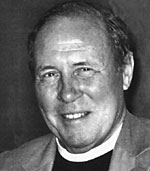
The Very Revd. John Dr. Moses.
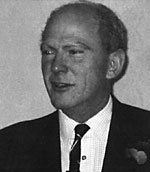
Mr. Robert Hildyard.
Annual luncheon
We were nearing capacity for this year's annual lunch when it returned to The Saracen's Head in Southwell on November 1st. Members were not disappointed: the room was most attractively turned out, the Saracen's staff were very helpful and the food extremely good, with much of it locally sourced.
Rosalys Coope, President, and John Beckett, Chairman, presided over the
event and we were pleased to welcome Robert Hildyard, nephew of Miles Thoroton
Hildyard of affectionate memory, who proposed the toast to the Society.
Also very welcome were the Very Revd. Dr. John Moses and Mrs. Susan Moses,
who have settled in Southwell on the retirement of Dr. Moses as Dean of
St. Paul's. Dr Moses, now a member of the Society, gave the after lunch
talk which 'lifted the dome of St. Paul's', giving his inside view on how
this great national and much loved building and institution works. He spoke
of the momentous occasions in the recent past where the cathedral has been
called on to respond to people's desire to come together to express feelings
of sorrow and shock, and also to celebrate great happenings. He described
the privilege he felt on being able to spend his last ten years of ministry
in such a place. Those listening to him felt that they were also privileged
to hear him speak so eloquently and movingly. All in all, it was a very
good luncheon. And for next year, something completely different.
Barbara
Cast, Hon. Secretary.
The Wentworth outing
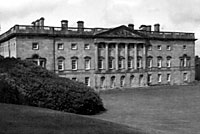
Wentworth House
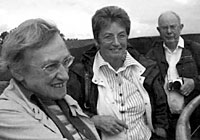
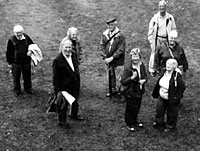
Members
enjoying the day.
How fortunate the Thoroton Society is to have such a loyal group of members who support the various visits that we make, such as the one to Wentworth Castle in South Yorkshire on 6 September 2008. We had a full coach and several other members made their own way there. On arrival we were greeted with biscuits and a good supply of tea and coffee, after which we were split into two groups; one to go round the House and the other to go round the Garden. Leaving the Visitor Centre we entered an area named after John Arnold, the first Head Gardener at Wentworth. This was planted with a fine dahlia border and gives excellent vistas across the park. The meadow below is being managed to promote wild flowers and tulips in the Spring. The path from here took us to a ha-ha, said to have been built in 1713 by Joseph Bower, and on to a fine dry stone bridge constructed by the Yorkshire Dry Stone Walling Association. From there we moved up to the Corinthian Temple that has recently been cleaned and restored giving a glimpse of a rotunda to the south east. This is in harmony with the Palladian south front of the House. William Wentworth no doubt saw this type of architecture whilst on the 'Grand Tour' in 1741. From the Temple we passed down Cedar Walk, lined on one side by handsome blue cedars planted by the Vernon Wentworth family in 1870. Close by is the rare Victorian Conservatory made famous by the BBC's Restoration Series and in dire need of being restored to its former glory. Also in this area are the Azalea, Union Jack and Victorian Flower Gardens. For those with a head for heights the next place of interest was Stainsborough Castle.
This is a folly built in the late 1720s as a playground for the children of the house on the site of a Motte and Bailey. From the top, on a clear day, there are commanding views over the surrounding countryside including Wentworth Woodhouse.
After a pleasant lunch the two groups changed over and the morning's Garden
group went on a tour of the house. This is now part of the Northern College
of Adult Education and, although most of the fixtures and fittings have
gone, the magnificent ceilings and covings are still in place. Of particular
note are the Blue Room, the Long Gallery, the Jacobean Staircase and
the Cantilevered Staircase.
Wentworth's house and gardens merit a visit for anyone. Our day finished
with a famous Thoroton tea with our thanks to the very knowledgeable guides
who led the groups and to our leaders, Ceril and Derek Little.
Bill
Clark
THE ARCHAEOLOGY LECTURE - Saturday, 18 October
2008
HENRY CHAPMAN - THE HATFIELD TRACKWAY AND PLATFORM: a Neolithic ceremonial site
in a wetland context

A few miles north of the Nottinghamshire border, to the west of the junction of the Trent with the Humber Estuary, are Thorne and Hatfield Moors, the largest peat bogs in Britain. Dr. Henry Chapman explained the environmental history of the area and how the rising sea level after the last Ice Age led to the formation of raised mires and a decline in tree cover in the Neolithic. He then concentrated on the corduroy trackway leading from dry land to a platform in the middle of a lake discovered at Hatfield. It was constructed of pine trunks from which a radiocarbon date was obtained putting it into the Neolithic as the earliest known trackway from Britain. No artefacts were discovered. Henry then discussed possible interpretations of the unique structure, comparing it to known monuments such as henges, favouring a ceremonial use of the platform which could be viewed from the land. During the lively question and discussion period after the lecture, the interpretation continued, including the possible significance of its approximate northerly orientation, and we were reminded of other trackways, all of later date, which have been found in the north of the county.